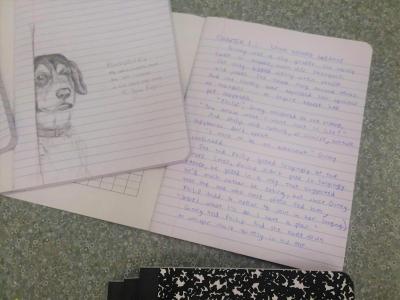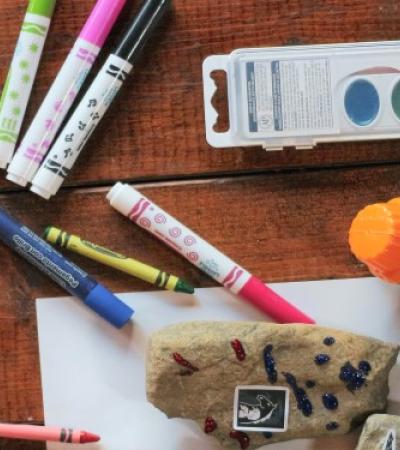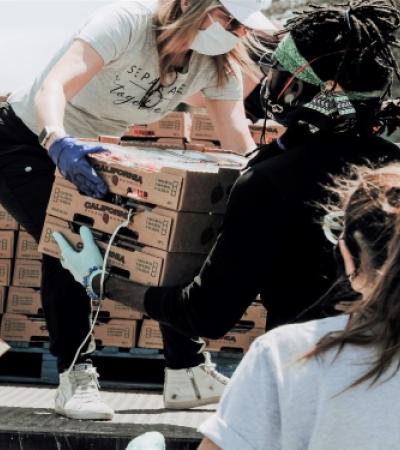Librarians Jenci Spradlin and Jennifer Brewer of Jackson-Madison County Library in Tennessee were coming off a summer of reduced hours. Their community had been socially distancing, and library staff wanted to get patrons connected in a new, creative way. With stacks of empty journals left over from a summer program, the two came up with the collaborative journaling program: The Pages of Madison County.
The 40 circulating journals, ready for patrons' contributions of writing and artwork, have themes ranging from Netflix Recommendations to Stories My Grandparents Told. Launched in September 2020, staff hope that the journals will help to add a personal community connection to an otherwise isolating time. Here, Spradlin and Brewer share how the journals came to be and how other libraries can start their own.
Where did the idea come from?
We purchased several hundred blank composition notebooks as part of our summer library program. Every participant received one and they could journal, draw, keep track of reading and complete ReadSquared missions. We had a lot of them left over and were brainstorming how we could use them now that summer was over.
We had also been thinking about how we could create community during a time of social distancing. Some of our ideas involved a pen pal program, a virtual book club and individual journaling. As we looked at the pros and cons of those ideas, we decided that a community journaling project could best serve to bring people together around common interests and allow them to share their creativity and experiences with each other.
The program is still brand new, having launched in early September, but we’re off to a good start. We have a collection of 40 journals. Many have already been checked out, and people have expressed excitement on our social media. Given that our main library is only open to the public to browse for six hours a day, with curbside in the morning and all day on Saturday, we are pleased with the use thus far and are encouraged that usage will continue to grow.

I love how there are so many themes to choose from. Where did all the ideas come from?
All the staff contributed ideas for the journals, and our ideas were based on what we thought might appeal to our community and to various age groups. We grouped our ideas into categories such as ongoing stories, sketchbooks, book and movie recommendations, fan fiction, memories, tips and future-oriented journals. Some of the journals are geared toward younger audiences, such as the continuing story “Giraffes in Space” and journals for fans of “Junie B. Jones,” “Diary of a Wimpy Kid” and “Harry Potter.” But we didn’t want to restrict any journal by age to encourage multi-generational dialogue.
I like that young and old alike can add sketches of pets or self-portraits, memories of our community, stories from this summer or ideas for the future of our community. We also encourage parents of pre-readers to engage their children and write out their responses for them. For adults who enjoy certain genres such as suspense or romance, they can share their favorite authors or books. We have a journal to share about their grandchildren, one for household tips and recipes, and even a journal to add prayer requests, as we are in the Bible Belt. Since we had ideas from nearly every staff member, everyone probably has a different favorite. It was a lot of fun to engage everyone in coming up with the ideas.
How do you deal with potential vulgar or inappropriate entries?
With each journal kit, we have an instruction sheet that states that all pages must be kid-friendly, G-rated, and kind or the pages will be removed. Once a journal is returned, we will review the entry made by the last borrower and decide on whether it meets those guidelines.
If we do decide to remove any pages, we let them know that a note will be placed on their account indicating such. The note isn’t about being punitive, but rather, it will help us answer their question if they notice their entry is missing. We will also be able to know if the entry was removed by staff verses torn out by another user. None of the entries have to be signed by the person who added it unless they choose to do so.
Why are these journals important to your community during the pandemic?
We hope that the project can help our community feel connected on a deeper level, emphasizing similarities through writing and art. The project removes any potential pre-conceived judgments based upon externalities. We can’t gather face-to-face, but we can still enjoy the one another’s company through this project.

Once a journal fills up, will they be archived?
We do plan to shelve these journals when they are completed, whenever that occurs. We talked about scanning them into a digital format, but we haven’t had to make that decision at this time. We decided to catalog them in 818 (American miscellaneous writing in English), although we are keeping them in a special display until they have been filled.
Finally, what advice do you have for other libraries that may want to start their own journals?
Be flexible, engage your whole staff and have fun. Let the project proceed in an organic fashion and don’t try to manipulate the process.
We ordered the journals in bulk from Dollar Tree, which was the best deal we found at the time. We also purchased poly envelopes to place the journal and instruction sheet inside for protection.
Don’t get overwhelmed or stressed about the rules because it could alienate people and stifle their creativity. We had various staff members to add the first entry to each journal to give people an idea of what they could do with the journal.
This could potentially be done electronically, but we think the connection aspect would be lost if people were only submitting their entries and not having the opportunity to read what others added.
Also, we didn’t want to limit participation to only those who are tech savvy or who have Internet access.



